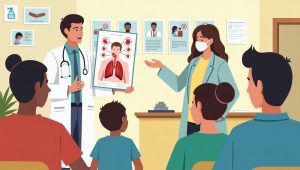
Human Metapneumovirus (HMPV) is a respiratory virus that, while often overlooked, has become a growing concern for public health worldwide. In Indonesia, where respiratory illnesses are already a significant cause of morbidity and mortality, understanding HMPV is crucial. This article explores what every Indonesian should know about HMPV, its symptoms, transmission, risks, and how to prevent its spread.
What is HMPV?
HMPV is a member of the Paramyxoviridae family, which includes other respiratory viruses like the respiratory syncytial virus (RSV). First identified in 2001, HMPV is primarily known for causing respiratory infections in both children and adults. The virus typically affects the upper and lower respiratory tracts, leading to symptoms such as fever, cough, sore throat, nasal congestion, and difficulty breathing. While most cases are mild, HMPV can cause severe complications, particularly in high-risk groups.
How is HMPV Transmitted?
HMPV is primarily spread through respiratory droplets when an infected person coughs, sneezes, or talks. It can also be transmitted by touching contaminated surfaces and then touching the face, particularly the eyes, nose, or mouth. This makes HMPV highly contagious, especially in crowded environments like schools, public transportation, and markets, which are common in densely populated urban areas such as Jakarta.
The virus can survive on surfaces for a period of time, further facilitating its spread. This is why it’s important to practice good hygiene and follow preventive measures to reduce transmission.
Symptoms of HMPV
The symptoms of HMPV are similar to those of other common respiratory infections, such as the flu or the common cold. They may include:
- Fever
- Cough (dry or productive)
- Nasal congestion
- Sore throat
- Shortness of breath or wheezing
- Fatigue
In many cases, the symptoms are mild and resolve within a week or two. However, for certain individuals, such as young children, the elderly, and those with weakened immune systems, HMPV can lead to more serious conditions like pneumonia or bronchiolitis, which may require hospitalization.
Who is at Risk?
While anyone can get infected with HMPV, certain groups are at higher risk for severe illness:
- Children under the age of 5: Infants and young children are more likely to develop severe respiratory issues when infected with HMPV.
- Elderly individuals: Older adults, particularly those with underlying health conditions, are more vulnerable to complications from the virus.
- People with weakened immune systems: Individuals with chronic illnesses, cancer, or those on immunosuppressive treatments are at greater risk for severe outcomes.
- Pregnant women: Although rare, pregnant women may experience more severe symptoms due to changes in their immune system.
Prevention of HMPV
Preventing the spread of HMPV is essential to controlling its impact on public health. Here are some effective preventive measures:
- Good hygiene: Frequent handwashing with soap and water for at least 20 seconds is one of the most effective ways to prevent the spread of HMPV. If soap and water are not available, use hand sanitizer with at least 60% alcohol.
- Covering coughs and sneezes: Always cover your mouth and nose with a tissue or your elbow when coughing or sneezing to prevent respiratory droplets from spreading.
- Avoid close contact with sick individuals: Stay away from people who are showing symptoms of respiratory illness, and avoid crowded places if you are feeling unwell.
- Cleaning surfaces: Regularly disinfect frequently touched surfaces such as doorknobs, light switches, and mobile phones to reduce the chance of surface transmission.
- Wearing masks: Wearing a mask, especially in crowded or enclosed spaces, can help reduce the spread of respiratory viruses like HMPV.
When to Seek Medical Help
If you or someone you know develops symptoms of HMPV and is at high risk for complications, it is important to seek medical attention promptly. Signs of severe illness, such as difficulty breathing, persistent high fever, or a significant decrease in energy levels, require immediate medical intervention. Early diagnosis and treatment can help prevent further complications and improve outcomes.
Conclusion
HMPV is an emerging respiratory virus that poses a significant health risk, particularly to vulnerable populations in Indonesia